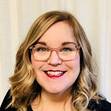Amy Sue Nathan's Blog: Women's Fiction Writers, page 13
October 15, 2016
Giveaway winner announced!
Thanks to random.org our winner is:
Stephanie Trietsch
Stephanie, please email me your mailing address (amysuenathan at gmail dot com) and I’ll get an ARC of Left To Chance in the mail to you as soon as I have them.
Yes, it’ll likely be months from now, but how awesome is it to forget you’ve won a prize and then to have it SHOW UP AT YOUR DOOR?
Of course there will be more giveaways here, on Goodreads, and lots of other places when the time comes. We authors just love our early and enthusiastic readers!
Hope you’re enjoying the weekend!
Amy xo
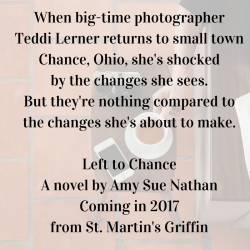
October 13, 2016
Happy Bookiversary to THE GOOD NEIGHBOR!
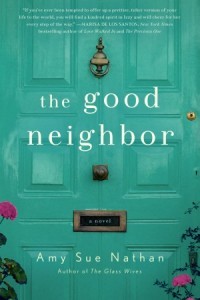
One year ago THE GOOD NEIGHBOR was published! Since then I’ve heard from many readers about what they loved (and didn’t love so much) about Izzy Lane, and her blogging escapades; Noah, her five-year-old son who wears capes and brandishes paper towel tube swords; Jade, the best friend and online media mogul who sees potential in Izzy she doesn’t see in herself; Rachel, the cousin who’s flirting with disaster by flirting online; and Mrs. Feldman, the octogenarian next-door-neighbor who teaches Izzy it’s better to tell the truth than to keep big secrets, which leads Mrs. Feldman to reveal secrets of her own.
So what have I been doing this past year? Writing and editing LEFT TO CHANCE (among gazillion other things), my third novel which is heading into production right now! I don’t have a pub date yet but I’m hoping for next Fall. Of course I’ll keep you posted!
If you’ve gotten this far, lucky you! While I don’t have Advance Reader Copies (ARCs) yet of LEFT TO CHANCE, I will have them eventually (like the specificity there?). Leave a comment here to pre-win (like pre-ordering, but FREE) an ARC of LEFT TO CHANCE as soon as it’s my hands. You’ll get a copy before your friends, even before some reviewers, because I’ll send you one of mine! I’ll choose a winner this weekend, announce it on the blog and email the winner for her address.
You have nothing to lose — and a book to gain. If that’s not enough, I’ll tell you that surprisingly, LEFT TO CHANCE became the most personal novel I’ve written so far. I slipped into the main character’s, Teddi Lerner’s, shoes, more easily than I had with Evie Glass or Izzy Lane. Does that mean it was easier to write? Hell no. It was the hardest book to write so far, and I’m super proud of the result.
Leave a comment and maybe you’ll pre-win an ARC!
Ready, set, go…AND THANK YOU!
Amy xo
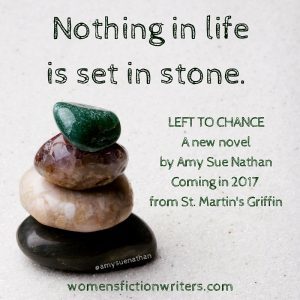


October 5, 2016
Guest Post: Debut Novelist Ella Joy Olsen Talks About Spheres of Influence In Writing
Today we have author Ella Joy Olsen here on WFW talking about Spheres of Influence. I’ll admit, I’d never heard of this before reading Ella’s post, and I was intrigued. It gave me a lot to think about it…and I’ll share my own ideas in the comments. I hope you’ll do the same and tell us all about your Spheres of Influence.
Now, let’s congratulate Ella on the publication of her debut novel, Root, Petal, Thorn! You’ll definitely want to check it out!
Amy xo
Spheres of Influence
By Ella Joy Olsen
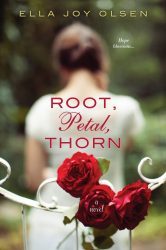 I started thinking about Spheres of Influence, in relation to my writing, the day after my fantastic, wonderfully attended, launch party. Someone asked me if I sold a lot of books. “Did I ever!” I squealed. “I sold through the bookstore’s purchase of one hundred copies. Plus twenty of my own.” The owner was giddy! I was thrilled. Everyone went home a little drunk.
I started thinking about Spheres of Influence, in relation to my writing, the day after my fantastic, wonderfully attended, launch party. Someone asked me if I sold a lot of books. “Did I ever!” I squealed. “I sold through the bookstore’s purchase of one hundred copies. Plus twenty of my own.” The owner was giddy! I was thrilled. Everyone went home a little drunk.
The next morning, in the haze of my book/champagne hangover, I realized that likely everyone I knew and loved (and could guilt into buying) now owned a copy of Root, Petal, Thorn. And one hundred and twenty books, though super flattering, does not a best-seller make.
After the hangover lifted, in a moment of clarity, I decided to categorize these book launch peeps into what I would call: Sphere One. These people–all attendees and all who I invited– were my most immediate Sphere of Influence, my sure thing. Every author has one of these beloved spheres. Mine consists of my family, friends, individuals I can identify on the street, or any person who I’d eventually know if they did (or did not) buy my book. These are the people I can ask candidly (or beg) to write a review on Amazon to get my reviews up to fifty, so the algorithm will give me a boost out of this small but important sphere.
On to Sphere Two. I’m lucky. My book is set in my hometown and includes a bunch of local history. Plus my hometown is Salt Lake City, a place where not many novels are set. This is not like a New York City author writing a book based in Manhattan. I knew if I poked around I’d get a little local coverage simply because I was unique.
And I did. I secured a nice article in the Sunday paper, a glossy local magazine, even a bit on a daily noon show. Sphere Two is a space where I have influence. I don’t know any of these people personally, but I can touch them through my OWN marketing efforts. I know where they live so I can send Facebook Ads their direction, I know they might be interested in my book because it involves their hometown, I can hold readings in their neighborhood book stores.
I can say honestly that I have worked this sphere with all I got. At the risk of sounding sleazy, I’ll admit to pimping myself all across my state. This is my only shot to be a home-grown debut author and my hands are cramping, because I’m milking it. I can see from Neilsen Book Scan that it’s working. I can check on my geographical sales and the area all around Utah is a beautiful dark blue. But am I a best seller? In any category? Not even close.
Enter Sphere Three. Actually, I wish I could enter. I want someone to give me a boost and pull me in, because to get a good spot in Sphere Three you need to know the bouncer. Lots of things can help you enter the party but most are outside of the author’s control. They are the “best of” lists compiled by widely read publications or celebrities, publisher dollars used to purchase banner ads on Goodreads or spots in pop-culture magazines, placement by a coveted retailer, or enormous giveaways that get your book into the hands of thousands of readers. These are the books that someone bigger than the author expects to be the “next big thing” and these books are given every opportunity to reach their hopeful potential. But will they make it to….Sphere Four?
Sphere Four is truly behind the veil, because no one really knows the path one must take to get here. To enter you have to break-out (or to keep on theme – break in). Some authors may have breadcrumbs leading them to this sphere, meaning a recognizable name, a loyal following, a trendy genre, or a bunch of advertising behind them. All these things help…but to enter there must be consensus. One must receive approval from all the little people who matter the most: the readers.
This is word-of-mouth, this is the book people are actually talking about, this is the book you have to read to keep up with water-cooler discussion. This is the genre-jumping, barrier-breaking, break-out hit. Once in this coveted sphere, you get to hang out for a sweet-spell, playing around on the biggest lists with the famous authors, while readers everywhere figure out that you’re in the cool circle and try to be your friend.
There are all walks of folks at this party. James Patterson enters through his own private revolving door (sometimes in the company of an unrecognizable side-kick), Andy Weir is truly looking around like he’s on Mars, E.L. James uncovered a naughty little trend and entered through the backdoor, J.K. Rowling worked some magic…and so on. Some get here once and never again and some can’t seem to leave.
Why? Now that’s the hundred thousand dollar question. Maybe the answer is engraved in the hallowed halls of Sphere Four, but I haven’t visited, so I’m not sure, and I have no answers.
But I do have this…one final takeaway: To make my point I’m going to drag you back to dear, sweet Sphere One. This lovely sphere of true-blues always thinks that there is a direct path from Sphere One to Sphere Four. If they don’t know any other authors, they believe that right after you walk out of the launch party at your local book store you’re boarding the fun bus to Sphere Four.
“Who knows?” Their eyes glisten with encouragement, as they buy one copy of your book. “I’ll look for your name on the best-seller lists.”
And that’s the crux of it. Who knows? And I won’t be able to help myself. I’ll be looking for my name on that list, too.
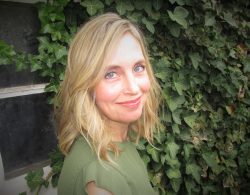
Ella Joy Olsen was born, raised, and currently resides in Salt Lake City, Utah – a charming town tucked against the massive Rocky Mountains. Most at home in the world of the written word, Ella spent nearly a decade on the Board of Directors for the Salt Lake City Public Library System (and four decades browsing the stacks). She is the mom of three kids ranging from barely-teen to barely-flown-the-nest teen, the mama of two dogs, and the wife of one patient husband.
Though she’s crazy about words, Ella is also practical, so she graduated from the University of Utah with a degree in Finance. After years spent typing boring stuff, Ella eagerly gave up her corner cubicle and started writing fiction. She has also lived in Seattle, Washington & Savannah, Georgia.
She is a member of Tall Poppy Writers, Women’s Fiction Writers Association, and the best book club ever: Salt Lake Bibliophiles.
ROOT, PETAL, THORN (September 2016/Kensington) is her debut novel. And coming in September 2017 – WHERE THE SWEET BIRD SINGS.
https://www.facebook.com/ella.joy.olsen.author
https://twitter.com/ellajoyolsen
https://www.instagram.com/ellajoyolsen/
September 28, 2016
Guest Post: Women’s Fiction Merges With Suspense by Kate Moretti
This was a very exciting week for my dear friend Kate Moretti with the launch of her much-anticipated thriller THE VANISHING YEAR. Kate is here today to share her thoughts on the how today’s popular genre of thrillers featuring women protagonists meshes with the genre of women’s fiction so many of us read and write.
Here’s the endorsement I was honored to write for THE VANISHING YEAR:
“Engaging, intriguing, heart pounding. In The Vanishing Year, Kate Moretti brings us the story of a Zoe Whittaker who has whitewashed her past and taken on a new and pristine identity. Of course, nothing is exactly as it seems to Zoe, and nothing is as it seems to the reader either. The twists had me gasping, the details had me transfixed. I cared about Zoe right away, which along with everything else, made it impossible for me to stop reading this book.”
Don’t miss out on THE VANISHING YEAR or Kate’s post. Explore for yourself how well these two genres blend together.
And please welcome Kate to WFW today!
Amy xo
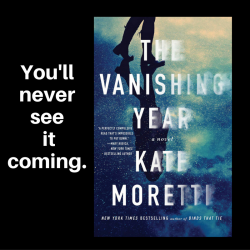
Women’s Fiction Merges with Suspense
by Kate Moretti
The genre of “Women’s Fiction” has been debated about for eons. The Women’s Fiction Writer’s Association says the story must revolve around the internal journey of a woman. Our own Amy Sue Nathan has said that in her novels, the main character saves herself.
Nathan Bransford has said “Thrillers have action. Suspense has danger, but not necessarily action. Mysteries have mysteries, i.e., something you don’t know until the end.”
It seems natural to marry Women’s Fiction and, say, romance. It also seems natural to marry Suspense and Thriller or Mystery. What comes less intuitively is this new boom in what seems to conjoin Women’s Fiction and Suspense, otherwise known as The Domestic Suspense novel.
Sarah Weinman coined the term Domestic Suspense after her compilation anthology “Troubled Daughters, Twisted Wives.” She called these noir writers of the 40’s through the 70’s the grandmothers of the genre, citing Patricia Highsmith, Shirley Jackson (of The Lottery fame), Vera Caspary, Margaret Millar as influential figures.
What I’ve seen in a rise in (in a post Gone Girl world), and absolutely adore, is this exploration into the a women’s internal journey while in the throes of something completely horrible, like a crime. I feel like the deepest truths emerge if you push your characters to the extreme, which to me almost always means the threat of life. I love the richness of this, there’s so much to dig through here.
How long will it take for a housewife to lie/steal/cheat/kill to protect her marriage/child/livelihood? This is the theme in Megan Abbott’s You Will Know Me. When a tragic fire seriously injures two college students, what lengths will their mothers, best friends and sister-in-laws, go to to unravel the truth, even if it means casting blame on the other? This was the story behind Carla Buckley’s The Good Goodbye. A victim of a serial killer escapes, grows up, has a daughter and becomes convinced her childhood testimony put the wrong man behind bars. Is she willing to risk the safety of her daughter to possibly exonerate the wrongly imprisoned? You’d have to read Black Eyed Susans, by Julia Heaberlin to find out. I’ve read all three of these books and continue to be impressed with the richness of character and the examination of the human condition, generally a trait of upmarket or literary stories.
These novels might be classified as suspense novels, but they have all the earmarks of Women’s Fiction. What they hold dearest is familiar to us: children, husbands, family, livelihood. Their journey is both external and internal – after all, you can’t risk everything and everyone you love and remain unchanged at the end. Life, and fiction, doesn’t work like that.
When you think of traditional mystery novels, you think of detectives and whodunnits. You think of police procedures or even possibly gun and car chases. While excellent (I love a good procedural), my interest mainly lie in these stories where the main characters are simply regular people, doing regular things, until they’re pushed to a breaking point. Where is that point? How far can you (as a writer) push? What emerges from that break is a wholly different character, for good or bad. The women in these novels undergo a pretty drastic internal transformation and this is where the heart of these stories lie.
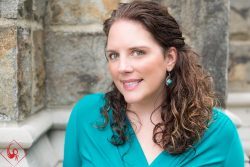 Kate Moretti is the New York Times Bestselling author of Thought I Knew You, While You Were Gone, and Binds That Tie. Her newest novel, The Vanishing Year will be available fall 2016. She lives in Pennsylvania with her husband and two kids. She’s worked in the pharmaceutical industry for ten years as a scientist, and has been an avid fiction reader her entire life. She enjoys traveling and cooking, although with two kids, a day job, and writing, she doesn’t get to do those things as much as she’d like.
Kate Moretti is the New York Times Bestselling author of Thought I Knew You, While You Were Gone, and Binds That Tie. Her newest novel, The Vanishing Year will be available fall 2016. She lives in Pennsylvania with her husband and two kids. She’s worked in the pharmaceutical industry for ten years as a scientist, and has been an avid fiction reader her entire life. She enjoys traveling and cooking, although with two kids, a day job, and writing, she doesn’t get to do those things as much as she’d like.
Her lifelong dream is to buy an old house with a secret passageway.
www.facebook.com/katemorettiwriter
www.instagram.com/KateMoretti1
Email: katemorettiauthor@gmail.com
September 22, 2016
Guest Post: Unlocking The Secrets To Email Marketing For Authors by Dana Kaye
Book publicity doesn’t have to be a mystery—not when Dana Kaye is around! Today, Dana is here on WFW sharing an excerpt from YOUR BOOK, YOUR BRAND, about email marketing for authors. It’s never too soon (or too late) to get started! So off I go…
Amy xo
Get In Your Reader’s Inbox: How To Utilize E-Mail Marketing
By Dana Kaye
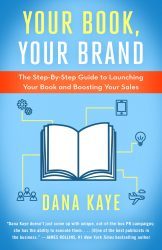 Email marketing is one of the most overlooked promotion tools authors have at their disposal, especially if you’re marketing to an older crowd. Not everyone is on Twitter, or spends a lot of time on Facebook, or reads the news online. But almost everyone, about 86.5% of the US population according to Internet Live Stats, has an email address. They may rarely use it, but if an email is in their inbox, they’ll see it, unlike Twitter and Facebook posts, which often get lost in the shuffle.
Email marketing is one of the most overlooked promotion tools authors have at their disposal, especially if you’re marketing to an older crowd. Not everyone is on Twitter, or spends a lot of time on Facebook, or reads the news online. But almost everyone, about 86.5% of the US population according to Internet Live Stats, has an email address. They may rarely use it, but if an email is in their inbox, they’ll see it, unlike Twitter and Facebook posts, which often get lost in the shuffle.
Services
There are a few email marketing services, some are free and some cost a small amount for every send. The one we use the most often is Mailchimp. It’s easy to use, highly customizable, and free if your mailing list is under 2,000 subscribers. There is also TinyLetter, which happens to be a spin-off of Mailchimp, which is an emailing service that is more personal and has fewer business features and analytics. Many authors say they prefer TinyLetter because it feels more personal and less like blatant self-promotion. Other services include Constant Contact and Vertical Response, both of which are paid services (usually pay-per-email sent) and a bit more difficult to customize. Some users report their emails are less likely to get caught in spam with the services Constant Contact or Vertical Response than with Mailchimp, but I haven’t had the experience of my Mailchimp messages being flagged as spam.
Building a List
Once you decide which service works best for you, sign up, create a list, and prepare a sign-up form. Add the newsletter sign-up form to your website and Facebook page (most have a Facebook integration tool that makes it easy). Once a month or so, remind your Twitter followers to sign up for your newsletter and include a link. I also advise authors to roll it in with a contest—maybe everyone who signs up before a certain date will receive a signed bookmark and bookplate, or one lucky winner will receive an Amazon gift card. Whatever it is, hosting a contest will encourage people to sign up and you’ll grow your list much faster.
Technically, people have to sign up for your mailing list themselves; you’re not allowed to add people without their permission. Many authors will stick to that rule; others will ignore it completely and add every person they ever met or swapped business cards with to their mailing list. I believe the ideal approach is somewhere in the middle.
Create a spreadsheet of friends and family members you think will be interested in receiving your newsletter and won’t be offended when it arrives in their inbox. Add any fans that have written you expressing interest in your work. If there are authors who have emailed you asking for a blurb or to read their manuscript or to connect them with your agent, add them to your list. My rule of thumb is that if they’ve expressed interest in you and your work, or if they’ve asked you for professional assistance, and they aren’t likely to get offended by receiving an email from you, add them. They can unsubscribe if they want.
Do not add book critics who have reviewed your book, but have never written you separately. Don’t add people you met at conferences and never corresponded with except to say, “Nice meeting you.” If they wouldn’t know you by name, they don’t belong on your list.
Many of you won’t feel comfortable doing that, and that’s fine. But most of us in the industry expect to be added to authors’ mailing lists, especially if we’ve written them in the past. To be honest, sometimes it’s a nice surprise. If I meet an author at a conference, get their card, and email them to say, “Nice meeting you” or “I loved your latest book,” I won’t always go to their website and seek out a newsletter sign up. But if they add me and they don’t send too many e-blasts, I definitely won’t unsubscribe and I am grateful for the reminder when they have a new book out.
When to Send and What to Say
When it comes to figuring out frequency of emails and what to include in each, a lot of it is common sense: don’t send emails every day, don’t be overly promotional, and don’t only send when you have a book out, but don’t send emails when you really have nothing to say. There are a few different ways to execute email marketing effectively, but whatever you decide, I recommend sticking with it and remaining consistent. If you decide to send semi-monthly or quarterly newsletters, stick with that schedule. If you only send 3 emails a year when you’re gearing up for a book launch, maintain that. Don’t change it dramatically just because you have a book out or there’s an initiative your publisher wants to promote. You train readers to know what to expect from you, and if you deviate too far from that expectation, you’ll lose subscribers.
If you write multiple books a year, publish in multiple arenas, or just have a lot going on that would interest your subscribers, then I recommend a quarterly or semi-monthly newsletter. This will allow you to connect with your readers on a regular basis and provide new and interesting information with each email. If you write one book a year or less, and that’s really the main focus of your email marketing, then you can opt to send 2–3 newsletters around your book launch, and that’s it. For this, I recommend sending one 8 weeks out, one 4 weeks out, then one on launch day.
When scheduling an email marketing campaign, you also want to consider the date, day of the week, and time it’s going out. About half of your subscribers will check their email at work, probably after they’ve cleared their professional inboxes. The other half will check it before they start their workday or in the evening when they return home. People’s inboxes are the fullest on Monday morning and emails sent on Friday afternoon are often overlooked. You want to pick the optimal time for people to open and read your content, rather than when they’re more likely to just delete the email because they’re pressed for time and overwhelmed by the amount in their inbox.
I used to always send emails mid-day, thinking that people are less likely to delete messages when their inboxes have been cleared. But a recent study conducted by Boomerang for Gmail revealed that email is 30% more likely to be opened if it’s sent between 6:00 and 7:00am. I started using this tact in our own newsletters, and right away, we noticed an increase in open rates. I attribute this to the type of content we’re sending; recipients may be more inclined to read a newsletter while they’re brushing their teeth, waiting for the train, or having their first cup of coffee. Wait too long and they’ve already started their day. They don’t have time to read about your upcoming book.
I usually send emails Tuesdays–Thursdays, unless Monday or Friday is a holiday, in which case I send on Wednesday. Lastly, you want to avoid sending e-blasts during the week of spring break, Thanksgiving break, or other times of the year when people travel. Your message will likely get buried under the rest of unwanted and non-emergency emails, and eventually deleted.
The content of the newsletters will vary depending on the schedule, but the key rule is the same: be consistent. If your newsletters always include some personal anecdotes, photos from research trips, little known facts about the region you write about, etc., then keep that up. Some authors, like Susan Dennard, opt to send a more service-based newsletter that includes writing tips, prompts, and publishing information. If you prefer to keep it about the book, that’s fine too. But it’s awkward, not to mention jarring, for your readers to transition from writing humorous, anecdotal, first-person emails about your recent research trip to an all-business, straight–book-information type email.
If you’re opting for the “only around the book launch” schedule, then I recommend including the following content in each newsletter:
Newsletter #1 (8 weeks prior to publication day): A synopsis of the upcoming book, buy links, any early reviews, and tour dates.
Newsletter #2 (4 weeks prior): Latest reviews of the book, a sample chapter or excerpt, tour schedule, buy links.
Newsletter #3 (launch day): A simple announcement that the book is out, with buy links. Keep it short and sweet.
If you’re aiming for more of an anecdotal or service-based newsletter, you’ll still want to send out a launch day announcement with links to buy the book. Since you wouldn’t have sent the previous two promotional newsletters listed above, I recommend including the tour dates, reviews, and an excerpt if available.
For all email blasts sent, you should ask yourself the question, “What benefit is the recipient getting from my newsletter?” The answer to that question should not be the privilege of receiving information about your book. Maybe it’s writing tips or advice. Maybe it’s extra content unavailable to the general public. In our newsletters, we give away free books with every blast. Whatever it is, there should be some tangible benefit for subscribing to your list. No one would sign up to receive an advertisement in their inbox each month.
This content was excerpted from Your Book, Your Brand: The Step-By-Step Guide to Launching Your Book and Boosting Your Sales, with permission from Dana Kaye and Diversion Books.
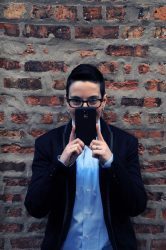 Dana Kaye is the owner of Kaye Publicity, Inc. and author of Your Book, Your Brand: The Step-By-Step Guide to Launching Your Book and Boosting Your Sales. Known for her innovative ideas and knowledge of current trends, she frequently speaks on the topics of social media, branding, and publishing trends, and teaches online courses at KayePublicity.teachable.com.
Dana Kaye is the owner of Kaye Publicity, Inc. and author of Your Book, Your Brand: The Step-By-Step Guide to Launching Your Book and Boosting Your Sales. Known for her innovative ideas and knowledge of current trends, she frequently speaks on the topics of social media, branding, and publishing trends, and teaches online courses at KayePublicity.teachable.com.
September 14, 2016
Guest Post: Understanding Magical Realism by author Susan Bishop Crispell
When I read THE SECRET INGREDIENT OF WISHES by Susan Bishop Crispell, I was absolutely honored to offer an endorsement. And now the book is available for all of you lucky readers who enjoy magical realism as it intertwines with women’s fiction! I’m thrilled to have Susan here on WFW talking about magical realism, what it means, and even, how to write it!
Here’s what I thought of the book:
“Susan Bishop Crispell delivers a page-turning and moving story of family, love, and second chances complete with touches of humor and heartache. If you don’t already believe in magic, you will, when you arrive in Nowhere, North Carolina along with Rachel Monroe, meet the town’s charismatic residents, and learn everyone’s secrets, hopes, and deepest fears. Fans of Sarah Addison Allen will delight in this bright new voice in romantic magical realism. I know I did!”
Please welcome Susan to WFW!
Amy xo
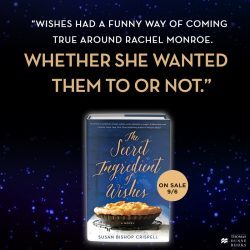
Blending Magic and Real Life into Must-Read Stories
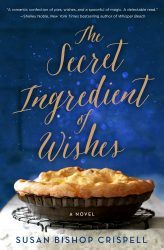 Magical realism is something that a lot of readers say they like to read and a lot of writers say they like to write. But it’s also a term that a lot of people don’t understand. I’ve seen it confused with light fantasy and paranormal and even urban fantasy. While magical realism might share some characteristics with these genres, it really goes so much deeper than what most people think.
Magical realism is something that a lot of readers say they like to read and a lot of writers say they like to write. But it’s also a term that a lot of people don’t understand. I’ve seen it confused with light fantasy and paranormal and even urban fantasy. While magical realism might share some characteristics with these genres, it really goes so much deeper than what most people think.
At its core, magical realism involves a story based in the world as we know it (whether historical or modern times) with touches of magic that are seamlessly woven into the characters, setting, and plot. Instead of being created and summoned via spells and incantations as in fantasy novels, the magic in magical realism is simply there, occurring naturally in the world without an explanation of how or why. The characters carry out their normal lives, working and having families and falling in love. But they also accept the magic and believe in it without question. That’s where the magic and the realism blend together.
Another key distinction of magical realism is that the magic is tied to the plot so its existence is as integral to the story as the characters are. In other words, without the magical elements, the story would not—could not—exist.
That’s because the magic is more than just a fantastical plot device. It’s the heart of the story, pulsing with a vibrant energy that brings the underlying culture and needs of the world to life on the page—and in the hearts of readers. With roots in Latin American literature, it’s not hard to see how the beauty and evocative descriptions of that culture have fueled magical realism for so long. My friend Anna-Marie McLemore, author of THE WEIGHT OF FEATHERS, wrote a beautiful article* for Writers Digest about magical realism and its roots in Latin American culture. I highly recommend hopping over there to read it to get an in-depth look at the cultural and deep emotional connections that drive so much of traditional magical realism.
In recent years, magical realism has gained a bigger following as more writers are leaving their personal touches on the genre. One of my favorite authors is Sarah Addison Allen, who writes what she calls “southern fried magical realism.” As a southern girl, I gravitate toward books set in the south that show off our small-town charm, hospitality, and food. I’ve always written quirky stories, but it wasn’t until I read Garden Spells that I understood what my genre was. Then I started seeking out magical realism books to gain a better understanding of what it really was and how to write it.
When I was writing THE SECRET INGREDIENT OF WISHES I read a tried to incorporate a lot of the elements I loved from some of my favorite magical realism books. Magic that makes the characters’ lives harder, like making wishes come true just by thinking about them and baking secrets into pies to keep them from getting out. Small-town relationships that are steeped in Southern culture, including gossiping neighbors and a barbecue festival and pies of every imaginable flavor. Quirky characters that beg for you to come sit on the front porch and stay awhile just to listen to their stories.
My stories tend to be more on the whimsical side than traditional magical realism, but that’s the beauty of writing. Each story holds a piece of the author, s snippet of their own story, and allows readers to experience a slice of the world that might not have seen before.
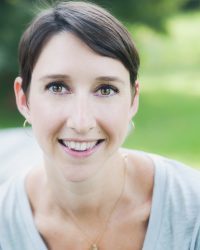 Susan Bishop Crispell earned a BFA in creative writing from the University of North Carolina at Wilmington. Born and raised in the mountains of Tennessee, she now lives twenty minutes from the beach in North Carolina with her husband and their literary-named cat. Susan is the author of THE SECRET INGREDIENT OF WISHES. As you might expect, she is very fond of pie. And she’s always on the lookout for hints of magic in the real world.
Susan Bishop Crispell earned a BFA in creative writing from the University of North Carolina at Wilmington. Born and raised in the mountains of Tennessee, she now lives twenty minutes from the beach in North Carolina with her husband and their literary-named cat. Susan is the author of THE SECRET INGREDIENT OF WISHES. As you might expect, she is very fond of pie. And she’s always on the lookout for hints of magic in the real world.Website: http://www.susanbishopcrispell.com/
Twitter: https://twitter.com/SBCrispell
Facebook: https://www.facebook.com/AuthorSusanBishopCrispell
Pinterest: https://www.pinterest.com/sbcrispell/
Here’s a link to the Writer’s Digest article about magical realism recommended by Susan!
September 11, 2016
To Life, in honor of September 11th
I repost this every year in honor of September 11th, at whatever blog I call home.
 The phone rang. It was Heather. Before she spoke, or perhaps while she was speaking, my thoughts shot back to a place I once called home — Maplewood, New Jersey. Only two train stops before the PATH leading right into Manhattan — over the river but truly a New York suburb, as are so many of the towns dotting the exits of the Garden State Parkway above Exit 9.
The phone rang. It was Heather. Before she spoke, or perhaps while she was speaking, my thoughts shot back to a place I once called home — Maplewood, New Jersey. Only two train stops before the PATH leading right into Manhattan — over the river but truly a New York suburb, as are so many of the towns dotting the exits of the Garden State Parkway above Exit 9.
In 2001 the woman on the phone still lived in this cozy bedroom community where my ex and I started our married life in 1990. It was the place he and I had moved from in 1994 and had never again visited. Although Heather and I had been fast friends since the time our babies,, born only one-day apart, were eight weeks old, we rarely spoke after my family moved from the area. Actually I think when she called that day in 2001 we probably hadn’t spoken in two or three years.
“Do you remember Doug Cherry?” she asked.
It wasn’t really a question.
“He was in Tower Two.”
I’m not sure what else she said.
Of course I remembered him. He played golf with my ex. Their little girl was one year younger than my son. Our dogs romped playfully together in the park on Sunday mornings. Doug’s wife and I were friends through a mutual friend. We all spent time together doing the suburban new-parent, dog-owner things. Whether someone was climbing up a playground or corporate ladder, it didn’t matter, we jelled.
Doug and his wife gave us our first gift when we moved into our new home – a charming 75 year old Cape-Cod with colonial blue shutters, meticulously placed on a heavily taxed 50×50 lot. They showed up at the door with a wrapped package — a set of four wine glasses. We were so touched. It was such a grown up thing, to receive wine glasses from friends, we thought. We would have them over for dinner, we agreed. And we did.
And when we were ready to embark on a cross-country move, they bid us fond farewell with a barbeque send off in their backyard amidst mutual friends. It was a lovely good-bye from friends we intended to keep. As we all know, intentions are only as good as the actions used to back them up and in subsequent moves we lost touch with our friends in New Jersey. It didn’t seem to matter.
Not only did I picture their little family’s picket fence corner lot home, but familiar streets lined with funeral processions. I saw abandoned cars in the train station parking lot. And in addition I now saw a face – and heard a voice – that had been part of my life. I pictured the family who I continued to know through Christmas cards without their staunch and smiling provider. I pictured a happy, lively woman my age as a beleaguered, grieving widow who now had three small children, eight and younger.
“Almost every child at school has lost someone,” Heather had added.
I was glad I didn’t live there anymore.
I never heard from Heather again – nor did I ever try to contact her. If I did, I don’t remember. And don’t care.
What I do remember and care about is that even amidst the isolation I felt during this time, I was glad I had something to hold onto. I had a tangible personal tribute that had been left in my charge. It was something to touch, and use, to honor the memory of someone who walked not only through my life but was had actually been a part of it for a short time.
I had the wine glasses.
And I still do. Well, I have two of the four wine glasses, as that’s the way things go with divorce.
Every Jewish holiday, and every Thanksgiving, when I pull out the linens and china, the silver and crystal, I set one special glass carefully at the head of the table just for me. I feel honored to have a piece of Doug in my family. I remember his kind and friendly and gracious personality when I see and use these goblets that are destined to remain the family heirlooms they have become. Before our meal I remind my children where the glasses came from. I tell a story of a short but delightful friendship to whomever graces our table.
And then I say, L’Chaim. To life.
In the years since 2001 I learned that Doug was the “other” man heard on Kevin Cosgrove’s recorded September 11th telephone call. Doug was the man Cosgrove mentioned by name in those moments before the collapse. Doug’s was a name and voice heard at the Moussaoui trials and around the world.
To life, indeed.
September 9, 2016
Literary Agent Seeking: Literary Agent Abby Saul, The Lark Group Is Seeking Women’s Fiction
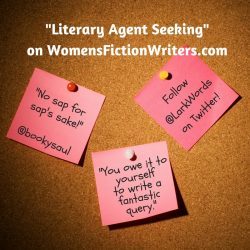
Hi WFW friends,
I’m thrilled to introduce you to Abby Saul (and I’m thrilled to introduce Abby to all of you)! Abby is spearheading a new literary agency and she’s looking for–eh hem–women’s fiction!
I’ve known Abby for more than four years, as she’s formerly with Browne and Miller Literary Associates. Abby has given me stellar editorial feedback on both The Good Neighbor and Left To Chance (due out next year). Recently we’ve even brainstormed on my idea for Book #4. Abby always has insight and a fresh point of view that resonated with me. I will miss having her “around” but also think she is going to kick-ass out on her own.
Abby’s here today to tell you about her new venture and about herself–and to offer some words of advice.
Please welcome Abby to WFW!
Amy xo

Hi Lovely Readers and Writers! With a big thanks to Amy for having me on her fantastic blog, I am delighted to have the chance to introduce myself and my new endeavor, The Lark Group, a literary agency seeking adult commercial and literary fiction.
I have always been a zealous reader of everything (my personal library runs the gamut from literary newbies and classics, to cozy mysteries, to sappy women’s fiction, to dark and twisted thrillers) and at The Lark Group I am seeking great and engrossing literary fiction, mysteries/thrillers, historical fiction, and—why I am here!—women’s fiction.
And that means I want YOU, women’s fiction writers, to query me!
To give you a sense of what I am looking for and how best to catch my eye, here are three facts:
I love women’s fiction that includes women in extraordinary settings (a crumbling mansion, a sandy beach house, a circus, a small town with a great cast of characters), harder edges (threats, dark secrets, a mystery to be solved), and capturing a life experience that is completely different from my own. I adore such talented authors as Liane Moriarty, Nicole Baart, Diane Setterfield, Amy Sue Nathan, Kate Morton, Elizabeth Blackwell, Alexander McCall Smith, and J. Courtney Sullivan, to name only a very few. Bottom Line: Transport me somewhere new and threaten to leave me there, and you will have me hooked!
I hate sappy sap for sap’s sake. A great women’s fiction project will pull on my heartstrings with real characters in real situations; a bad one will give me a dead dog and a sick child and other sad elements in an implausible setting. Bottom Line: Make me laugh and cry because of how much I love the story and the characters, not laugh at how much you are trying to make me cry.
You owe it to yourself to write a fantastic query. The worst thing you can do is spend a ton of time perfecting your manuscript and then whip up a query without much thought. Take the time to ensure you are sending a well-crafted, clean (proofread!), and polished query. Tell me exactly what your book is, and make me excited to read it. When you are writing your synopsis, look at the back cover copy of one of your favorite books: how did the publisher succinctly summarize enough of the story to pull you in and make you want to read more? Bottom Line: Do that for your book—and eliminate the typos—and you will get manuscript requests.
I founded The Lark Group after a decade in publishing at John Wiley & Sons, Sourcebooks, and Browne & Miller Literary Associates, where I worked with and edited bestselling and award-winning authors and major brands. At each of those publishing groups, I have also helped to establish ebook standards, led company-wide forums to explore new digital possibilities for books, and created and managed numerous digital initiatives.
Having a finger in both pies—the traditional editorial and the innovative digital—has given me a unique view of the industry (plus some major jam hands), and this perspective is one of the assets I’m bringing to my new agency. At The Lark Group, I am committed to providing individual and proactive representation to debut and established authors, as well as creating an agile space for publishing experimentation and innovation.
I am excited to hear from you! Find me online and get in touch:
@BookySaul and @LarkWords on Twitter
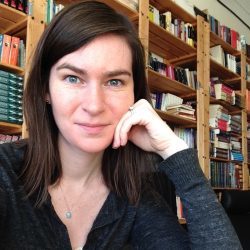
September 7, 2016
Brandi Megan Granett Says “No Excuses” When It Comes To Writing
Today we welcome one of my fellow Tall Poppy Writers to Women’s Fiction Writers! Brandi Megan Granett has a long publishing history and a brand new novel, TRIPLE LOVE SCORE. She also has great advice for just sitting down and getting it done!
Please welcome Brandi to WFW!
Amy xo
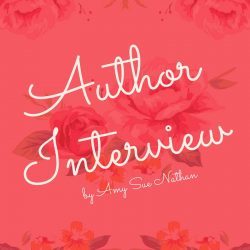
Author Brandi Megan Granett Says “No Excuses” When It Comes To Writing
Amy: Congratulations on TRIPLE LOVE SCORE! Can you tell us a little bit about the premise of this novel?
Brandi: Miranda Shane lives a quiet life among books and letters as a professor in a small upstate town. When the playing-by-the-rules poet throws out convention and begins to use a Scrabble board instead of paper to write, she sets off a chain of events that rattles her carefully planned world. Her awakening propels her to take risks and seize chances she previously let slip by, including a game-changing offer from the man she let slip away. But when the revelation of an affair with a graduate student threatens the new life Miranda created, she is forced to decide between love or poetry.
Amy: What moment or person or place sparked the idea for this book? Do you remember how/when/where that happened?
Brandi: The short answer to this is that I fell in love. After my divorce, all of sudden my best friend became something more. And I really started to have fun again on all fronts. This inspired me to start writing after a long writing drought. Each day I tried to write something to my now boyfriend; something to make him laugh, smile or cry, and well, you know, maybe think about getting home early. In Triple Love Score, Miranda explores the choices she has to make her own life, much as I did at the time I wrote it.
Amy: This isn’t your first novel. Can you share with us a little about your publishing history?
Brandi: My first novel, My Intended, was published in 2000 with William Morrow. Harper Collins bought Morrow in the middle of my contract, a little bit before the book came out. I lost my entire team–the editor, the marketing team–to layoffs. At the same time, my daughter was born so, needless to say, being a mom easily eclipsed the experience of being a first time novelist. I am excited to be trying something new this time by publishing with Wyatt-Mackenzie, a small publisher who is really working to support Triple Love Score and me. I love that I have someone on my team that didn’t flinch when I missed a meeting because I promised my daughter we would take our Corgi, Red Sharkey, out for ice cream for his birthday.
Amy: We all grow and change through the years. Has your approach to novel writing changed? Was this gradual and organic or intentional?
Brandi: My process certainly evolved. My Intended was written over the course of two years through my workshops in the MFA Program at Sarah Lawrence College. In the early 2000s, I did NaNoWriMo and finished creating a novel titled Tarnished, which I later revised for my PhD in Creative Writing. After the frenetic pace of NaNoWriMo left me never wanting to write again, but amazed at the power of a daily practice, I decided to try again, albeit with a less ambitious daily goal of 500 words. And sure enough, if you put your butt in the chair every day, the work gets done, and Triple Love Score came into being. This practice really resonates with me, and I still use it when I am working on my next novel, Straight Shooter.
Amy: What’s your best advice for aspiring authors of women’s fiction in today’s publishing climate?
Brandi: My best advice has a few different parts:
1. Write every day. No excuses. No scented candles. No ceremony. Just do it.
2. Don’t revise before the story is done. You will be wasting time polishing the first page and never get to the end.
3. Build a community. My membership in the Tall Poppy Writers, a collective of women fiction writers, helps me to keep perspective, make connections, and learn new things about this writing game all the time.
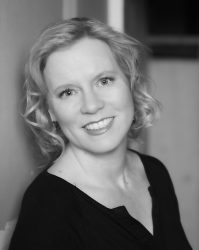 Brandi Megan Granett is an author, online English professor, and writing coach. She earned her Ph.D. in Creative Writing at Aberystwyth University and her MFA in Fiction from Sarah Lawrence College. Her latest novel, Triple Love Score, is published by Wyatt-Mackenzie. Morrow published her first novel, My Intended, in 2000. Her short fiction appeared in Pebble Lake Review, Folio, Pleiades, and other literary magazines and is collected in the volume, Cars and Other Things That Get Around. When she is not writing or teaching or mothering, you will find her on the archery range.
Brandi Megan Granett is an author, online English professor, and writing coach. She earned her Ph.D. in Creative Writing at Aberystwyth University and her MFA in Fiction from Sarah Lawrence College. Her latest novel, Triple Love Score, is published by Wyatt-Mackenzie. Morrow published her first novel, My Intended, in 2000. Her short fiction appeared in Pebble Lake Review, Folio, Pleiades, and other literary magazines and is collected in the volume, Cars and Other Things That Get Around. When she is not writing or teaching or mothering, you will find her on the archery range.
Find out more about Brandi on her website and check out her Huffington Post column.
August 30, 2016
Guest Post: A Publishing Confession—I Want To Make Money by Tina Ann Forkner
I’ve been friends with author Tina Ann Forkner for about nine years now! OMG! Nine years! She’s a loyal friend and a fabulous writer. We’ve had many conversations via email, text, phone, and in person. We’ve talked writing, life, the writing life, and the writing business. Tina is level-headed, smart, and as practical as this writing gig allows. So when she wanted to share with all of you (and me) her thoughts on writing — and wanted to make money doing it — I said YOU BETCHA. Sometimes we think we’re insulting our art by wanting or even needing to make money doing it. I’m with Tina — while I love to write, this is my job, and it needs to bring in some (vegan for me, thankyouverymuch) bacon!
Please share your thoughts in the comments! And check out Tina’s book covers, and a photo of the two of us!
Amy xo
Click to view slideshow.
A Publishing Confession: I Want to Make Money
By Tina Ann Forkner
This is one of those posts that I might regret writing tomorrow, but I need to say this. I am writing for money.
There, I said it. I want to make money from my career. If you stumbled upon this post because of the title, my admission probably sounds ridiculous. Who doesn’t want to get paid for their work? Everybody! But you see, I am a writer. If you are a writer, I’m talking to you because I need to make this admission in a safe place, and even if you aren’t in the same place as I am, I believe that most of you are. If this is an error in my thinking, please set me straight.
Writers aren’t supposed to do it for the money. Our culture says we should practice our art for art’s sake, but when is art ever given away? Okay, maybe by the same people who are in the same boat as we writers are, but seriously, when has anyone ever offered you a free Picasso? No? Have you ever walked into a bookstore and they were handing out free books? No? That’s never happened to me, either, and yet as the author of books, I am not supposed to care about money.
In fact, as an author, I am supposed to promote my books, but I am not actually supposed to ask people to buy them. I’m supposed to merely suggest the idea, not even in words, but through a secret message by putting the books out there in front of people and hoping a lightbulb pops on that says, “Hey! I will buy this book.” Otherwise, I might offend the customers by looking like a salesman, as if I might be trying to get them to be part of a pyramid scheme or something. I don’t know, maybe it’s hidden in the plot? It’s a strange way to sell books. Think about it, can you imagine the chef of a restaurant bringing you plates of food and just showing them to you, then walking away and leaving it up to you to say, “Hey, can I buy that?”
Well, as my husband says when he hears a terrible idea, “I’m not buying that.” I think it’s a terrible idea to get into publishing only for the love of it. I want to sell my books and not be passive-aggressive about it because I think my writing is worth more than to give it away. Don’t get me wrong. Of course I love writing, but in the end, it’s not only about the beautiful words and the stories that have the opportunity to inspire and sometimes even change a reader’s outlook on life. I wish writing could be about just those things, the way it was back when I was in college and it was all pure and only about writing. But that’s a pipe dream, my friends, a cliché my English professors would scribble all over if they read this. That was before I achieved what was at the time, an impossible dream. I got published.
Now, I’ve achieved the publishing dream that most of my English Degree peers have not yet reached. I even get to say that I was traditionally published my first time around and have not one, but five books, as well as a brief list of decent accomplishments related to my stories, but it turns out that those things are not enough. My stories, no matter how beloved by my readers, are not enough to measure up in the world of mainstream fiction. To the people who make the rules, it’s not enough. To all of those who decide what books the stores will carry, who write the algorithms that decide what books the online customers will see, and who give their premium space to the highest bidder, I am not enough.
I’m not talking about self-fulfillment. My heart is full because my readers are kind, gracious with their praise, and eager for my stories. I could not ask for better readers and I love interacting with them. They make my heart full. What’s empty, though, is my author wallet. We aren’t ever supposed to say that, are we? Not if we are true writers. We’re supposed to say that we write for only the love and passion of it. Heck, I’ve said it! If we are true writers, we need to pretend in front of our readers that we don’t have an electric bill, the cost of college, and the healthcare costs of a five person family. Why we aren’t supposed to admit publicly that we are working for money, I am not sure, but sometimes, I want to stand up and scream, “I am worth more than this!”
Since this is mainly an emotional rant to fellow authors (who will understand and maybe secretly cheer, but probably not loudly), let’s talk a little bit about the why and how. We all know that while publishing opportunities as a whole have opened up, the marketing of books has largely been thrown back into the hands of authors unless you are already famous. I’m not famous, and I could easily start my own marketing business with the hours and dollars I have spent marketing all of my books. I am happy to do my part, sure. I even enjoy it, but is all this work enough?
Apparently not. I am racked with guilt about how much time I have spent Not Writing and have instead put into marketing. What it boils down to is that I have barely turned a profit and despite a few days in a #1 slot on an Amazon Best Seller list and being able to add award-winning to my title, I cannot get a foothold. Maybe I’m doing it wrong. Maybe my readers are just being nice and I suck, but I think they are smarter and busier than that. They are the ones who keep me going and the best part about being an author in this day and age is that I have actually made friends with many of my awesome readers. Some of them feel like they know me, and the feeling is totally mutual. I love that about being an author.
In fact, I love being an author. I love writing stories. I love sharing those stories with my readers and if I had a couple hundred thousand more readers just like them, I could do this and never feel guilty, never feel tired, and never feel depressed that after eight years of being published I still write in what sometimes feels like obscurity no matter how much time and money I have invested.
I do have a part-time day job, as well, and I happen to be married to a hardworking husband, but even mentioning these things makes my writing sound like a hobby. All of you writers out there know that writing is not a hobby. You know this, right? Because if you are treating it like a hobby, you might be contributing to the perception that writers don’t deserve to get paid, and I want to be paid. Don’t you?
Writing is what we’re good at. It’s what we love to do. We should expect to earn money for our work. Imagine being in the Mary Kay or home party jewelry business and not wanting to earn money. Not to mention that when I buy my make up from my consultant, I pay a heck of a lot more than people would if they bought all five of my books. Can you believe that? Five books for the price of a couple of tubes of lipstick. I love my lipstick, but I don’t expect to get it for free.
So, that’s my rant. Cry me a river, right? Don’t send any tissues. I’m stocked up. And don’t send me any sad songs because I’m just as disgusted with myself for feeling this way as you might be by the fact that I am airing our dirty laundry in a public forum. And I say our dirty laundry because surely I am not the only one who feels this way.
Please tell me I’m not the only one.
What’s the solution? I guess there isn’t one, unless attitudes about books and authors change. Customers have been trained to want our products for free or for almost nothing. Libraries are struggling to stay open and bookstores, even Indies (so slap me), although at a slower rate, are less and less for the author these days.
Sometimes, I wonder, what would everyone do if we all put down our pens? Would our protest even matter? Of course, the question is pointless because it will never happen. Even I don’t want it to happen. We will always write. We have to write. We can’t not write.
For now, probably like most of the rest of you, I am a bondservant to my own pen.
Tina Ann Forkner is an award-winning author of five novels including Waking Up Joy, The Real Thing, and Nashville by Heart. She works by day as a Substitute Teacher and lives in Wyoming with her husband and three teenagers. Learn more about her novels at www.tinaannforkner.com, where you can also buy them.
Women's Fiction Writers
- Amy Sue Nathan's profile
- 543 followers


